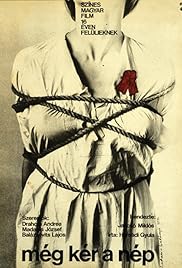RED PSALM (MEG KER A NEP)
(director: Miklos Jancso; screenwriter: Gyula Hernádi; cinematographer: Janos Kende; choreography: Ferene Pesovar; editor: Zoltan Farkas; music: Tamas Cseh; cast: Andrea Drahota (Nagy Mária, szocialista), Lajos Balazsovite (Fiatal tiszt, Cadet), Andras Balint (Majláth gróf, Count), Gyongyi Buros (Ráczné, szocialista), Jozsef Madaros (Hegedüs Bálint, szocialista), Tibor Molnar (Lovas Imre, szocialista), Tibor Orban (Pongrácz András, szocialista), Bertalan Solti (Öreg Hegedüs), Tamas Cseh (Énekes), Zoltán Nagy (Táncos), László Nagy (Táncos), Márk Zala (Janos Nagy), Peter Haumann (Priest), Elemer Ragalyi(Fõhadnagy,Officer); Runtime: 90; MPAA Rating: NR; Focus; 1972-Hungary-in Hungarian with English subtitles)
“Vibrant socialist musical.”
Reviewed by Dennis Schwartz
Meg Ker A Nep, the Hungarian title, means “And the People Still Ask.” Hungarian Communist filmmaker Miklos Jancso (“The Round-up”/”The Red And The White”/”My Way Home”) takes less than 28 shots to film this vibrant socialist musical. What goes for a narrative is written by Gyula Hernádi. The director basically eschews narrative to film in choreographed ballet-like movements a pattern of tyranny and revolution in the country and makes good use of symbols to get home his workers unite message. The good guy farm worker chorus sings ‘Instead of luck we were hit by misfortune,’ to explain the class differences with their social betters. Though there was much to be admired about this filming technique, it never was a completely enjoyable viewing experience because the film dragged in spots and its Communist dialectic propaganda message while delivered with conviction still could be faulted as merely propaganda.
It’s set in the 1890s, on the vast Hungarian estate of a wealthy count (Andras Balint), where a group of striking collective farm workers unite and wait for an answer to their demands. On horseback the army arrives, but do not act when three pretty naked women dance in front of them and they instead participate in the festival celebration. Afterwards the unarmed pacifist strikers are fired upon by the soldiers.
The color red is used to convey emblematic visual meanings, such as a hand wound is pictured as a red rosette, a red river running through the farm shows the blood from the workers slain by the soldiers, and the lady in red fires at soldiers with a pistol wrapped in a red ribbon.
The film’s socialist message is crystal clear, showing the filmmaker in favor of the abused landless farm workers demanding a fair wage and basic rights from the powerful land owners. The musical numbers are dazzling, perhaps even equal to Hollywood’s finest. Some might object to the Lord’s Pray introduced as Communist doctrine and sung as part of the worker’s responses to the authorities, but the music is tastefully done. It’s clearly a well-made populist film for the people, with the filmmaker telling of their cflass struggle and rooting for their victory. Through the symbolic use of the red psalm that doubles as a rosette of hope, Jancso’s political folk tale hopes to unite nature lovers, pagans, Communists and progressive Christians to fight peacefully on the side of the underdog workers.
It wonJancso a best director prize at Cannes.

REVIEWED ON 7/10/2012 GRADE: B+